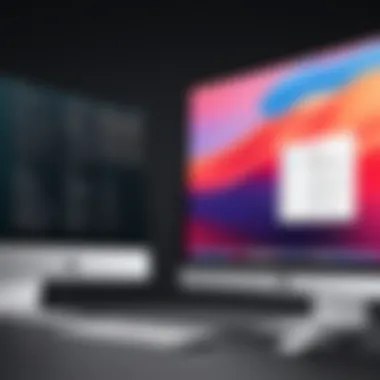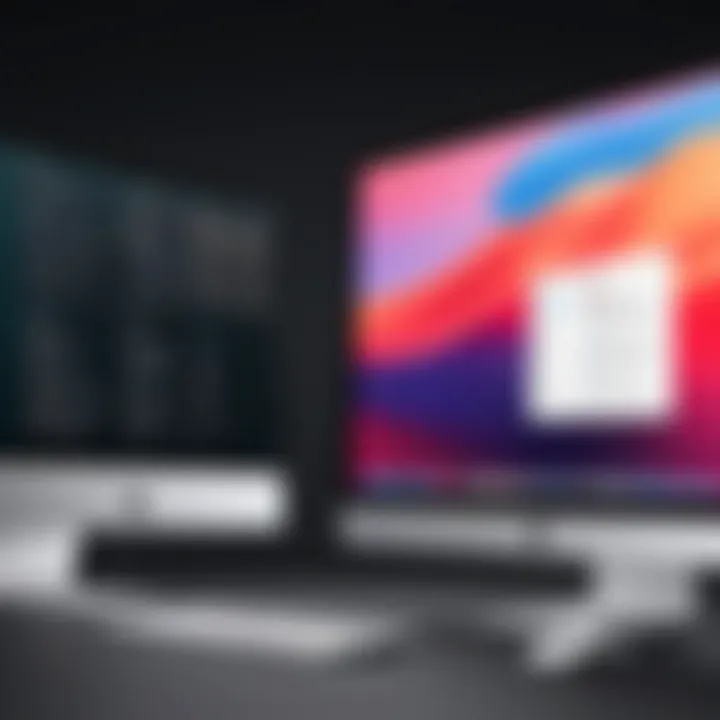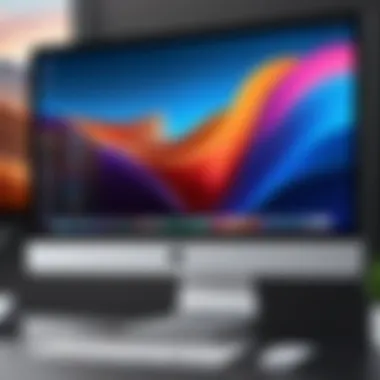Mastering Windows on M1 Mac: A Complete Guide


Intro
The advent of Apple's M1 silicon represents a significant shift in the computing landscape. The M1 Mac offers enhanced performance and energy efficiency, making it attractive for various professional tasks. However, for IT professionals and tech enthusiasts, the need to run Windows can arise due to software requirements or testing purposes. Understanding how to effectively run Windows on these devices is crucial for optimizing workflows.
This article delves into the methods available for running Windows on M1 Macs, the benefits and limitations of each, and practical steps to achieve this dual-OS environment. The information presented will empower users to make informed decisions and potentially enhance their productivity in a multi-platform context.
Features Overview
When running Windows on an M1 Mac, it is essential to consider the specifications and selling points of both the hardware and available virtualization solutions.
Key Specifications
- M1 Chip: The M1 chip's eight-core CPU and unified memory architecture provide impressive speed and efficient performance, significantly impacting how Windows operates on the device.
- RAM: Depending on the model, M1 Macs generally come with 8GB or 16GB of RAM, which is crucial for multitasking environments that OS virtualization may create.
- Storage: With SSD options ranging from 256GB up to 2TB or more, sufficient space for Windows and applications will be essential.
Unique Selling Points
- Performance: M1 technology increases performance per watt, enhancing battery life while maintaining robust processing capabilities.
- Integration: Seamless integration between macOS and Windows make it easier for users to share files and resources across platforms.
- Virtualization options: There are various software options such as Parallels Desktop and VMware Fusion specifically designed to run on M1 architecture, ensuring smoother experiences compared to traditional methods.
Performance Analysis
Understanding the performance dynamics when running Windows on M1 Macs can guide decision-making on the best practices and methods to use.
Benchmarking Results
Recent benchmarks indicate that when running Windows 10 via Parallels Desktop, M1 Macs can handle tasks quite efficiently. For example, CPU-intensive applications run comparably to or even faster than traditional x86 architecture, thanks to the M1's efficiency.
Real-world Scenarios
In practical usage scenarios, M1 Macs demonstrate strong performance in specific applications like software development environments or data analysis tools that usually run smoother on a native Windows installation. However, it is important to note that very specific software requiring direct hardware access may face limitations or performance bottlenecks.
"Understanding the compatibility and performance of Windows on M1 Macs could be the key to optimizing your workflow."
Understanding the M1 Architecture
The shift from Intel processors to Apple's M1 architecture marks a significant evolution in computing technology. This transition is not just a matter of brand preference; it fundamentally alters how software operates on these devices. For IT professionals and enthusiasts, grasping the nuances of the M1 architecture is critical for optimizing workflows and leveraging the advantages of dual operating systems.
Difference between M1 and Intel Processors
M1 chips utilize ARM architecture, which is distinct from the x86 architecture of Intel processors. This difference introduces variations in power efficiency, performance, and compatibility.
- Power Efficiency: M1 processors are renowned for their efficiency. They consume less energy while providing comparable, if not superior, performance than Intel chips. This can result in better battery life for laptops, a critical aspect for professionals on-the-go.
- Performance Metrics: Benchmarks show that M1 performs exceptionally well in single-core tasks. In many multi-core situations, it also holds its own against higher-end Intel chips. This is vital for applications that depend on strong processing capabilities.
- Compatibility Considerations: Programs designed for x86 architectures need to be adapted or run through emulation on the M1. This may impact performance or usability, an essential factor IT professionals must consider when selecting software.
Impact of ARM Architecture on Software Compatibility
ARM architecture significantly influences software interactions. This underpinned all sorts of applications, from productivity tools to specialized software used in various industries.
- Application Support: Many popular applications are slowly becoming compatible with ARM. Developers are updating their software, but this is an ongoing process. Professionals should verify application support before transitioning to an M1 Mac.
- Emulation Layer: Rosetta 2 acts as a translation tool that allows Intel-based applications to run on the M1. While this tool is quite effective, it is not foolproof. Performance may sometimes lag behind that of native ARM applications.
- Future of Compatibility: The trend sees more software developers targeting the ARM architecture. This encouraging sign suggests that long-term compatibility will expand, easing the transition for users.
In sum, understanding the M1 architecture is crucial for informed decision-making about running Windows or specific applications on M1 Macs. The differences compared to Intel processors and the implications of ARM architecture on software compatibility are pivotal considerations in maximizing productivity and efficiency.
Exploring Windows on M1 Options
Exploring options for running Windows on M1 Macs is essential for users who need to leverage Windows applications while enjoying the advanced capabilities of Apple's latest silicon. As many IT professionals are aware, the transition from Intel processors to the ARM architecture of M1 offers new possibilities and challenges. The methods available for running Windows on this architecture can enhance productivity, ensure software compatibility, and streamline workflows. Effective implementation of these options can lead to significant advantages when managing diverse software needs.
Native Virtualization with Parallels Desktop
Parallels Desktop is perhaps the flagship virtualization solution for running Windows on M1 Macs. This software allows users to run Windows alongside macOS without the need to reboot. Its seamless integration offers an experience akin to having Windows natively on the device. Important features include easy file sharing, drag and drop functionality between systems, and the ability to run applications from either OS in the same workspace.


Setting up Parallels Desktop is straightforward. Users simply need to download the installation file, follow setup prompts, and configure the virtual machine by allocating resources such as CPU and RAM. In addition, the software supports various Windows versions, allowing users to choose between several options that best suit their needs.
It is important to note that while performance is generally strong, there may be specific scenarios where limitations arise due to the ARM architecture. Understanding these performance characteristics is vital for optimal use.
Using Boot Camp Alternatives
Unlike Intel-based Macs, M1 Macs do not support Boot Camp natively. This presents a particular challenge for those accustomed to dual-booting. However, alternatives do exist. Solutions such as UTM and QEMU allow users to emulate x86 architecture, enabling the installation of Windows.
These tools come with their own set of advantages and considerations. For example, UTM allows users to run Windows within a virtual machine, providing a degree of performance generally suitable for basic tasks. However, performance may not be as robust as that seen with native virtualization solutions like Parallels Desktop. Users must weigh their need for speed against the flexibility these alternatives provide.
Crossover Technology Insights
Another interesting option is Crossover, a software that allows users to run Windows applications on macOS without needing a full installation of Windows. Crossover facilitates the use of Windows-based software by using Wine as its backbone, translating Windows calls into POSIX calls. This method eliminates the need for a separate Windows installation while supporting a variety of Windows applications.
While Crossover may not support every application, it excels with well-known titles and is particularly effective for users whose software needs are limited to specific programs. Its lightweight nature makes it appealing for those who want to avoid the overhead of full virtualization solutions.
Overall, exploring these options will provide clarity on how best to operate Windows on M1. Each method carries its own benefits and downsides, ultimately leading to diversified decision-making based on user needs and preferences.
Setting Up Parallels Desktop
Setting up Parallels Desktop is a crucial element in the process of running Windows on M1 Macs. This virtualization software enables users to run Windows alongside macOS seamlessly. For many IT professionals and tech enthusiasts, the ability to operate both operating systems concurrently presents a unique opportunity to enhance productivity and streamline workflows. Parallels Desktop supports the ARM version of Windows 11, which is specifically designed for Apple’s M1 architecture. Therefore, understanding how to effectively set up this software is pivotal in utilizing the full capabilities of an M1 Mac.
Installation Process Overview
The installation of Parallels Desktop is straightforward but requires attention to detail. Begin by ensuring that your M1 Mac meets the minimum system requirements for the software. After downloading the installer from the Parallels website, follow these steps:
- Locate the Installer: Find the downloaded .dmg file in your Downloads folder.
- Double-Click to Open: Open the installer by double-clicking on it. This will mount the disk image.
- Run the Installer: Inside the mounted disk image, locate the Parallels Desktop icon and double-click it to begin installation.
- Follow Prompts: Follow the on-screen prompts to complete the installation. You may need to enter your administrator password.
- Activate: Once installed, you can activate Parallels with your purchased license or start a free trial.
After the installation, a setup wizard will guide you through the process of installing Windows. This is an essential phase, as Parallels will prompt you to download Windows 11 for ARM if you do not have an existing image.
Configuring Windows Settings
Setting up Windows requires careful configuration to optimize performance and usability. Here are key steps during this process:
- Assign Resources: Within Parallels Desktop, you can allocate CPU cores and RAM to your Windows instance. This ensures Windows runs efficiently alongside macOS. Aim to balance the resource allocation based on your usual workload.
- Adjust Display Settings: Configuring the display settings helps tailor the visual experience. Choose between different resolutions and enable Retina support for optimal clarity.
- Installation of Tools: After installing Windows, be sure to install Parallels Tools. This set of utilities enhances integration between macOS and Windows, improving mouse and keyboard functionality.
Performance Optimization Tips
Optimizing performance in Parallels Desktop can greatly enhance your experience running Windows on an M1 Mac. Consider these strategies:
- Use Coherence Mode: Coherence mode allows Windows applications to run seamlessly alongside macOS apps, promoting a more integrated workflow.
- Allocate Sufficient Disk Space: Ensure that virtual machine has enough disk space to run applications without lag. Adjust the configuration as needed in the Parallels settings.
- Regular Updates: Keeping both macOS and Parallels Desktop up to date can fix bugs and improve performance. Check for updates regularly and apply them promptly.
- Utilize Snapshots: Parallels Desktop allows you to take snapshots of your Windows environment. This can be beneficial for testing newer software without risking your setup.
By setting up Parallels Desktop properly, configuring Windows settings efficiently, and optimizing performance, M1 Mac users can significantly enhance their productivity while using Windows applications. This comprehensive approach ensures that the virtualized environment runs smoothly and responds well to the demands of complex tasks.
Running Windows Applications Smoothly
Running Windows applications on an M1 Mac is a critical aspect for IT professionals and tech enthusiasts alike. The performance of these applications directly impacts productivity, making it essential to understand how to effectively run them. Different software may behave differently based on how it was designed and optimized. To maximize the productivity gains of dual operating systems, it is vital to address several key elements, including compatibility checks and potential troubleshooting tactics.
Compatibility Check for Applications
Before diving into using any Windows application on an M1 Mac, perform a thorough compatibility check. This step is necessary to ensure that the programs you intend to run will function properly. Not all Windows applications are optimized for ARM architecture, which is employed in M1 Macs.
To verify compatibility, consider these methods:
- Official Application Support: Check the software’s official website or documentation. Many developers now indicate ARM compatibility for their programs.
- User Forums and Communities: Websites like Reddit can provide insights and experiences from other users. Search threads about specific applications to see if others have faced issues or successfully run them on M1.
- Testing Tools: Some tools can help identify compatibility, such as CrossOver, which can test Windows applications in a simulated environment.
If an application is not compatible, you may need to explore alternatives or workarounds.
Troubleshooting Common Issues


Despite thorough preparation, challenges may arise when running Windows applications on an M1 Mac. Understanding common issues can save time and frustration. Here are some frequent problems and their solutions:
- Performance Lag: If applications experience slow performance, check the settings in Parallels Desktop or VMware Fusion. Depending on your configuration, allocating more CPU or RAM resources can significantly enhance performance.
- Installation Failures: Sometimes, applications fail to install correctly. Ensure you are using the latest versions of your virtualization software, as updates often fix known bugs.
- Application Crashes: If an application crashes frequently, check for updates or patches from the developer. They might already be aware of compatibility issues with ARM architecture.
In more complex scenarios, consult IT forums or technical support for specialized advice on application-specific issues.
Proper checks and strategy are crucial for a smooth experience when running Windows applications.
Finding effective ways to run Windows applications seamlessly on M1 Macs enhances overall productivity and utilizes the full potential of the hardware. Taking the time to check compatibility and being prepared with troubleshooting steps will ensure that your experience is as smooth as possible.
Advantages of Running Windows on M1 Mac
Running Windows on an M1 Mac presents unique opportunities that can significantly improve productivity for IT professionals and tech enthusiasts alike. The ability to utilize two operating systems on a single device means that users can enjoy the benefits and flexibility that both MacOS and Windows offer. This dual OS approach helps in managing workflows, increasing efficiency, and streamlining tasks that require different software environments.
The following points encapsulate the importance of exploring the advantages of running Windows on M1 Mac:
- Increased Work Efficiency: Professionals can switch between environments without the need for multiple devices. This consolidation saves time and reduces context-switching, which can be disruptive to workflow.
- Broader Software Access: Many enterprise-grade applications are designed for Windows. Having Windows readily available means users can access critical tools and programs that might not have MacOS equivalents.
- Cost-Effectiveness: Instead of investing in a second device, users can run Windows on existing M1 hardware. This can be a significant reduction in expenses, especially for small businesses or freelancers.
Enhanced Productivity with Dual OS
Using both MacOS and Windows allows for an increase in overall productivity. IT professionals can harness the strengths of MacOS for programming or design tasks while leveraging Windows for specific applications required in corporate environments.
By running Windows on an M1 Mac, users can:
- Seamlessly switch between OSs: This versatility minimizes disruptions caused by switching devices.
- Utilize productivity software available on both platforms: This enables users to take advantage of features and strengths inherent to each OS.
- Run resource-intensive applications: M1 Mac’s performance capabilities mean that running demanding Windows applications is feasible and efficient, optimizing both time and resources.
Access to Windows-Specific Software
One of the significant advantages of running Windows on an M1 Mac lies in the access to specialized software that is only available on the Windows platform. Many businesses rely on software suites such as Microsoft Access, Visio, or specific tools tailored to Windows.
Understanding the importance of these Windows-specific applications can be crucial for:
- Data Analysis: Applications like Microsoft Access or Statistica are cheaper and more accessible on Windows.
- Professional Software: Engineering tools like AutoCAD or certain versions of Adobe Creative Suite work more smoothly or only exist on Windows versions.
- Gaming: Although not a primary use for most IT professionals, the ability to run Windows-based games opens up opportunities for leisure activities on the same device.
Utilizing an M1 Mac to run Windows provides a unique leverage point for professionals seeking to maximize functionality without the downsides of dual hardware management.
Overall, the advantages of running Windows on an M1 Mac create a compelling case for professionals exploring this route to enhance their technical capabilities and efficiencies.
Comparing Virtualization Software
In the realm of running Windows on M1 Macs, the choice of virtualization software is crucial. This section will consider the two leading softwares: Parallels Desktop and VMware Fusion. Each option comes with its specific benefits and considerations that impact overall functionality and user experience.
Parallels vs. VMware Fusion
Parallels Desktop has emerged as a robust option for users seeking to run Windows on their M1 Macs. It offers seamless integration with the macOS environment, offering features such as Coherence Mode, which allows users to run Windows applications alongside Mac applications without needing to switch back and forth. Users often cite the ease of use as a major factor, making it particularly appealing for non-technical users.
On the other hand, VMware Fusion caters more to power users and IT professionals who require deeper control and flexibility. VMware Fusion supports a wide range of operating systems beyond just Windows, making it versatile for developers or IT environments looking to test multiple systems. It also offers features such as snapshots and the ability to create virtual networks.
Key Differences:
- User Interface: Parallels is known for its intuitive interface, while VMware may have a steeper learning curve.
- Integration: Parallels excels in integrating with macOS, while VMware Fusion provides more extensive options for various systems.
- Target Audience: Parallels targets casual users, whereas VMware Fusion appeals to IT professionals and developers.
Performance and Pricing Analysis
When considering virtualization software, performance and pricing are two essential factors. Parallels Desktop generally performs better on M1 due to its optimization for ARM architecture. It offers fast boot times and quick application responsiveness, which enhances the overall user experience when running Windows applications. Many users report that applications run smoothly, making it the preferred choice for those who prioritize performance.
In terms of pricing, Parallels Desktop and VMware Fusion vary slightly. Parallels typically requires a subscription or a one-time purchase, which might deter some users. In contrast, VMware Fusion provides a one-time purchase model but lacks some of the advanced features found in Parallels, particularly for the newer M1 architecture.
"Choosing the right virtualization software can significantly improve user experience on M1 Macs when running Windows."


Considerations:
- Use Case: Casual users might prefer the user-friendly approach of Parallels, while developers needing varied environments may lean towards VMware.
- Budget: Analyze long-term costs; while Parallels may appear more costly initially, its performance could justify the expense.
Both options provide significant capabilities, and the decision should align with the specific needs of the user. Understanding these differences will help you optimize your setup, ensuring a smoother operation for multitasking between macOS and Windows.
Navigating Limitations and Challenges
In the realm of running Windows on M1 Macs, understanding the limitations and challenges is crucial for IT professionals. This section addresses various hurdles one might face when trying to implement dual operating systems, ensuring that users are well-informed and prepared. Knowing these factors can help in making informed decisions that could optimize workflow and avoid unnecessary complications.
General Limitations of Virtualization
Virtualization allows one operating system to run within another. However, there are inherent limitations to this technology. One primary challenge is performance overhead. Virtual machines often do not run as efficiently as a natively installed system due to the additional resources needed for virtualization.
Another limitation is hardware compatibility. Certain peripherals and hardware components may not function correctly or at all when virtualized. For example, specialized graphics cards or some USB devices may not seamlessly integrate with a virtual environment.
- Resource Allocation: Virtual machines require a portion of system resources, which can lead to slower performance if the host doesn’t have enough RAM or processing power.
- Feature Restrictions: Not all features of the host OS may be available in the virtual environment, leading to potential gaps in functionality.
These limitations can impact productivity, especially for intensive applications that rely heavily on hardware capabilities. It is essential for users to evaluate their requirements and determine whether virtualization meets their needs effectively.
M1-Specific Constraints
Running Windows on Apple’s M1 Mac presents unique challenges due to its ARM architecture. Traditional Windows versions, designed for x86 processors, may face compatibility issues. Many applications do not yet support ARM, limiting the usability of certain software that users may rely on for their daily tasks.
Another constraint includes the performance ceiling. While the M1 chip offers impressive performance, running unoptimized software can lead to slower processing times. For instance, applications built for Intel processors might not run as smoothly on M1, even with emulation layers in place.
As of now, native ARM versions of Windows are still in development, affecting the broad adoption of this setup.
Furthermore, users may encounter licensing issues when attempting to run Windows on ARM, which can add another layer of complexity. Ensuring that you have the correct licenses for software can vary based on the virtualization method used. All these constraints underscore the importance of assessing your specific use case and understanding both the potential and limitations of running Windows on M1 Macs.
Future of Running Windows on M1 Macs
The landscape of computing is constantly evolving. Apple’s transition to M1 architecture introduced significant changes, especially in the realm of compatibility with various operating systems, particularly Windows. Understanding the future of running Windows on M1 Macs is essential for IT professionals and tech enthusiasts alike. This section will explore anticipated improvements in compatibility as well as long-term performance expectations. Both elements play a vital role in enhancing user experiences and driving efficiencies in workflows.
Anticipated Improvement in Compatibility
As software developers continue to adapt to the M1 architecture, improvements in compatibility are expected. One of the primary challenges has been the ARM architecture’s nuances compared to traditional x86 processors. However, companies like Microsoft are working on optimizing Windows for ARM. This effort will likely result in better integration, allowing more applications to run natively on M1 Macs.
- Windows ARM Versions: Microsoft has already released Windows 11 for ARM. Future versions may address compatibility issues that users currently face.
- Wider Application Support: Developers are being encouraged to refactor their applications to support ARM natively. As more programs become available, users will benefit from an expanded range of software options.
- Enhanced Virtualization Tools: Virtualization software, such as Parallels Desktop, is continuously updating to support better compatibility and performance with Windows on ARM. This will help bridge the gap and create a smoother user experience.
"The increasing support for ARM architecture by key software vendors signals a promising future for running Windows on M1 devices."
Long-Term Performance Expectations
Looking ahead, it's essential to consider how the performance of Windows on M1 Macs might evolve. With Apple’s ongoing advancements in silicon technology, users can expect sustained improvements in processing power and efficiency. This directly impacts how well Windows runs on these devices.
- Increased Efficiency: M1 chips are designed to optimize various tasks effectively. As software evolves to exploit these capabilities, users will notice better responsiveness and resource management.
- Higher Performance Benchmarks: With ongoing updates and optimizations in both operating systems, we may see Windows running with performance benchmarks that were once only achievable on native macOS applications.
- Greater Resource Allocation: Future updates may allow users to allocate resources more effectively between macOS and Windows applications, maximizing the use of the hardware.
User Experiences and Case Studies
Understanding how users interact with Windows on M1 Macs provides valuable insights into this unique operation environment. The experiences of individuals, especially those in professional settings, offer a practical viewpoint that theory alone cannot provide. Case studies can illuminate the benefits and challenges users face, as well as highlight effective strategies for optimizing setup and usage. This section merges theoretical knowledge with real-world applications, making it an essential component of this guide.
Professional Use Cases
Many professionals utilize both macOS and Windows for various tasks. Software developers, graphic designers, and data analysts offer compelling scenarios.
- Software Development: Developers may prefer macOS for its Unix-based environment while requiring Windows for specific IDEs or .NET applications. Running Windows via Parallels allows developers to switch seamlessly between environments and test applications across both platforms.
- Graphic Design: Designers often use Adobe Suite, which is available on both operating systems. Some specific tools, however, might be limited to Windows. For urgent projects, running Windows on an M1 Mac can save valuable time without needing a separate machine.
- Data Analysis: Analysts frequently rely on powerful Windows-only software such as certain versions of Microsoft Excel or statistical analysis tools. Using virtualization software ensures that they have access to the essential applications required for analysis and reporting.
"Running Windows on my M1 has revolutionized my workflow. The speed and efficiency mean I'm not slowed down by needing multiple machines."
— A software developer’s perspective.
Feedback from IT Professionals
The synthesized feedback from IT professionals is crucial in assessing the viability of Windows on M1 Macs. Reviews often touch on performance, compatibility, and the overall user experience.
- Performance Insights: Many IT professionals emphasize the strong performance of Parallels Desktop when running Windows on M1 architectures. Speed tests and benchmarking indicate appreciable improvements in applications running natively.
- Compatibility Concerns: In terms of software compatibility, IT professionals report varying experiences. While many applications work smoothly, others might have limitations based on the ARM architecture. Regular updates from Parallels and similar platforms aim to address these challenges.
- User Experience: Feedback indicates that user experience often improves with familiarity to the dual system, with many professionals appreciating the ability to run Windows-only applications without reboots. The ability to share files seamlessly between macOS and Windows further enhances workflow, minimizing disruptions.



